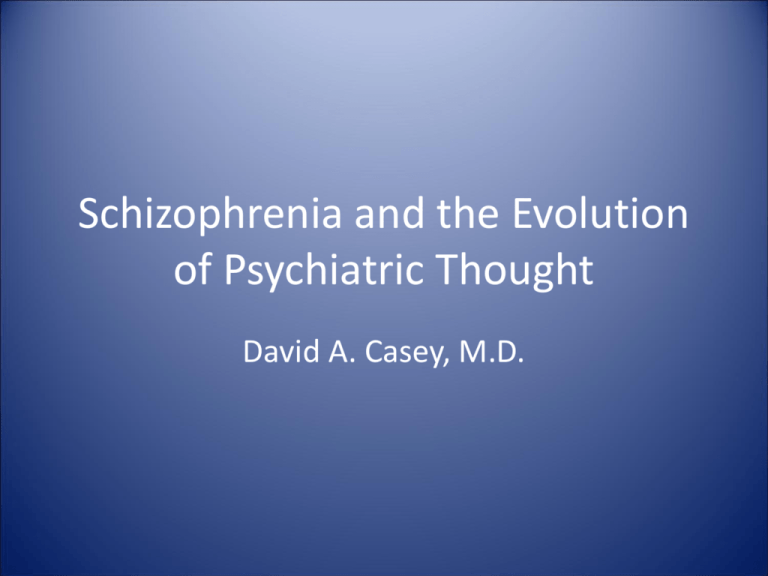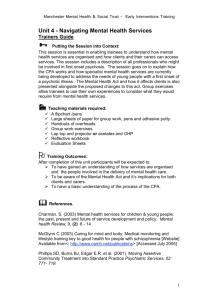Schizophrenia and the Evolution of Psychiatric Thought
advertisement

Schizophrenia and the Evolution of Psychiatric Thought David A. Casey, M.D. Introduction • We will briefly discuss schizophrenia • We will then briefly explore a few of the many questions it raises • Fair warning: this talk is a work in progress-for me and for the profession of psychiatry • Therefore, I do not claim to know the answers! • “Why can’t psychiatry be more black and white like the rest of medicine”? Schizophrenia • Severe, persistent psychiatric disorder characterized by psychosis, thought disorder and other symptoms • Onset typically late adolescence or young adulthood, but variable • Several subtypes of unclear significance • Paranoid, undifferentiated, catatonic, disorganized Schizophrenia • Positive symptoms: hallucinations and delusions (psychosis) • Hallucinations: sensory experiences without basis in reality • Schizophrenic hallucinations typically auditory • Delusions: fixed false beliefs • Delusions and/or hallucinations: psychosis Schizophrenia • Positive and negative symptoms • Positive: psychosis • Negative: illogical thinking (thought disorder), executive dysfunction, disturbed affect, loss of function, cognitive disturbance • Phases: prodromal, active, residual Schizophrenia • • • • Affects both sexes equally All known cultures and groups Roughly 1—2% prevalence Genetic component but no controlling gene(s) identified • Involves dysfunction of dopamine circuitsregarded by most psychiatrists as a brain disease • Typically chronic course with exacerbations; more negative symptoms, cognitive loss with aging Schizophrenia • Often described as incurable, but various levels of recovery possible • Outcomes may vary among cultures • Treatment typically involves antipsychotic medications (dopamine blockers) which tend to affect positive symptoms but do little for negative symptoms Treatment • Antipsychotic drugs: many categories often grouped into “typical” and “atypical” • Atypicals are the current class—arguably cause less parkinsonism than older drugs • However, atypicals associated with weight gain, glucose intolerance and DM, metabolic syndrome, increased cardiovascular risk profile • Current reexamination of their merits relative to older (and far cheaper) drugs Medical Co-morbidity • High incidence of obesity, hyperlipidemia, DM II, heart disease • How much are atypicals responsible? • High rates of smoking as well as drug and alcohol abuse • Low medical adherence rates • Adverse diets and lifestyles • USA: Dramatic reduction in life expectancy—by 15-20 years Schizophrenia • Schizophrenia is probably the most serious and disabling psychiatric disorder • It is also the among the most controversial • Exploration of the history of schizophrenia gives insight into the evolution of psychiatric thought Images of Schizophrenia (clockwise, from top left: John Nash, Jack Kerouac, Peter Green, Syd Barrett Questions raised by Schizophrenia • Are psychiatric disorders biological, psychological, or social in origin? • Should they be regarded as medical problems? • Nature vs nurture • How about free will? • Mind/brain dualism • Have psychiatric disorders always existed in humanity? • Have they changed or evolved as society has changed? • Politics and schizophrenia: “sluggish” schizophrenia Questions • Should society intervene in the lives of those labeled mentally ill, even against their will? • Does mental illness lead to violence? • Do psychiatric disorders occur in discrete categories (as implied by DSM-IV TR) or as a variety of symptoms each occurring as points on a spectrum from normal to abnormal? • Does labeling patients lead to stigma? • Can schizophrenia be adaptive? When did Schizophrenia Emerge? • No consensus • Psychosis is described in many ancient texts, but not clearly equivalent to modern concept of schizophrenia • Middle ages: demonic possession, witchcraft, persecution (especially of women) • Beginnings of asylums (“Bedlam”) 18th Century • First case descriptions equivalent to modern concept of schizophrenia • Enlightenment ideals applied sporadically to mentally ill (e.g., Pinel) • Later authors (Foucault) claimed Enlightenment ideals actually marginalized, pathologized, or even “created” mentally ill Kraeplin • Emil Kraeplin (Germany) was the first great nosologist in psychiatry • Kept records of symptoms and course of large numbers of chronically hospitalized patients and separated them into categories • Popularized the term “dementia praecox” (1897) for early life onset psychosis and cognitive decline; to be distinguished from senile dementia • Focused on mental deterioration, psychosis Emil Kraeplin Bleuler • Eugen Bleuler (Switzerland) coined term “schizophrenia” (1911) • He did not see severe cognitive decline in all patients and disliked the term dementia • Regarded schizophrenia as a split between various aspects of the mind • “Schiz”: split • “Phrene”: mind Bleuler • The “A’s”: associations, affect, ambivalence, autism • “Loose” associations • Blunted/flat/inappropriate affect • Ambivalence: inability to make decisions • Autism: self-involvement, fantasy world • Deemphasized critical importance of psychosis Eugen Bleuler Dissociative disorder • Note: schizophrenia is not to be confused with “split personality” • Split personality: multiple personality or dissociative identity disorder Schneider • Kurt Schneider added another element to the definition (1920s): “first rank symptoms” • FRS: thought insertion, thought withdrawal, delusions of control, ideas of reference • “bizarre or patently absurd” delusions which are impossible, as opposed to paranoia or other delusions which could theoretically be reality based Kurt Schneider Asylum Era • In the USA, the most seriously ill were grouped in asylums • Kentucky had a number, of which 3 were most important still exist • Central State, Eastern State, Western State • Every state has one or more • Over 500,000 by about 1950 • Warehousing Central State Hospital “Lakeland” US Diagnoses-20th Century • Americans adopted a very broad concept of schizophrenia, incorporating all the previous ideas; schizophrenia much more commonly diagnosed in US • Virtually any chronically mentally ill person might have been diagnosed as schizophrenic • DSM-I and DSM-II very broad, loosely described categories; psychoanalytic concepts Lobotomy • Prefrontal leucotomy (“lobotomy”) popularized by Moniz (Portugal) and Freeman (US) in 1930s-1950s. • Largely used for agitated schizophrenics • Cautionary tale Walter Freeman and Egas Moniz Deinstitutionalization • • • • • • • • 1950s-1960s Advent of first antipsychotic drugs Chlorpromazine (“Thorazine”) Patients rights and liberation movements Community mental health movement Backlash against medical model Antipsychiatry movement Dangerousness criteria and due process in commitment laws 1950s-1960s-Psychosis as Personal Struggle • RD Laing: schizophrenia as a search for meaning: “Being sane in an insane world” • Bateson: The “double-bind hypothesis”; the “schizophrenogenic” mother • Thomas Szasz: “The Myth of Mental Illness” • Foucault : “Madness and Civilization” • Pirsig: “Zen and the Art of Motorcycle Maintenance” • Denber and others: LSD experiments R.D. Laing and Thomas Szasz Robert and Chris Pirsig DSM-III (1980) • • • • • • • • Biological research in schizophrenia Development of criterion based diagnosis Narrowing of diagnosis Advent of lithium---backing in to diagnosis Dissatisfaction with DSM-II Reaction to antipsychiatry movement DSM-III was a revolution in psychiatric practice Introduced diagnostic criteria, multi-axial diagnosis; considered validity and reliability, ended reliance on analytic concepts • Assumed categorical diagnoses • Did not end controversy—think Scientology! Atypical Antipsychotics (1990s-current) • “Atypical” refers to lack of parkinsonism • Thought to be breakthrough • Zyprexa, Risperdal, Seroquel, Geodon, Abilify, Invega • Growing concerns about effectiveness, cost, side-effects • Heavily promoted--contributes to concerns about role of Pharma in psychiatry Genetics • Search for “gene for schizophrenia” proved fruitless • No longer considered to be a simple genetic disorder • Probably a number of genetic influences on a variety of cellular processes • Controller genes which switch on/off during development, or with environment may be involved Genetics • Bipolar and other mood disorders probably share some common genetics • Schizophrenia probably not a unitary disorder from a genetic viewpoint • Leading to reexamination of assumptions about boundaries of disorders Critics of Psychiatry • Today’s critics focus on overuse of medications, over-involvement of Pharma • Patients’ groups seek autonomy and normalization: “voice hearers” associations, “Morgellon’s” support groups • UK-move away from categorical diagnosis to dimensional approach, seeing symptoms in context of patients’ life, paying attention to content of delusions Emerging Thoughts • Brain as a plastic instrument—synthesizing genetic and experiential inputs into its anatomy, physiology, and psychology • False dichotomies: nature/nurture; mind/brain, etc. • Limits of pharmacotherapies • Search for new integrative paradigm to better understand dimensions of schizophrenia • Patient as partner rather than object






